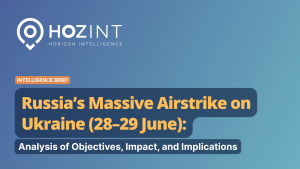Key Points
-
Russia launched its largest air attack of the three-year war, firing over 500 aerial weapons overnight between 28 and 29 June 2025.
-
The strikes targeted military-industrial facilities and oil refineries across regions far from the frontline.
-
Ukraine’s defensive success (shooting down most of the drones and missiles) highlights both its vulnerability and its need for more advanced air defences.
-
This escalation undermines Moscow’s claimed openness to peace talks and suggests Russia seeks to maintain pressure on Ukraine’s economy and morale.
-
The attack likely foreshadows a drawn-out war of attrition in 2025, with intensified targeting of infrastructure to weaken Ukraine’s war-fighting potential.
Event Description
What: In the night between June 28 and 29, Russia launched what Ukraine describes as the largest air attack since its February 2022 full-scale invasion. The assault involved over 477 drones and decoys, plus 60 missiles fired at Ukrainian targets. Despite Ukraine shooting down 475 of these, the scale marked an unprecedented escalation.
When: The attack occurred overnight between 28 and 29 June 2025, during the ongoing summer phase of the conflict.
Who:
Attacker: The Russian military.
Defender: Ukraine’s armed forces and civilian population.
Victims: Ukrainian civilians (at least 2 killed, 12 injured, including children), and infrastructure across several regions.
Where: Targets were spread widely across Ukraine—including cities far from the frontline such as Kyiv, Lviv (west), Drohobych, Poltava, Mykolaiv, Dnipropetrovsk, Cherkasy, and Ivano-Frankivsk. An industrial facility in Drohobych caught fire after a drone strike that also caused power outages.
How: Russia used a large, complex mixed barrage:
477 drones and decoys to overwhelm defences.
60 missiles, many likely high-precision.
This approach aims to exhaust and penetrate Ukraine’s air-defence systems.
Why: Russia claims it targeted military-industrial sites and oil refineries. Strategically, this kind of attack seeks to degrade Ukraine’s war-fighting capacity, damage its economy, and erode civilian morale.
Analysis
The immediate impact of the overnight attack between 28 and 29 June 2025 has been profound. Ukraine’s air force called it the “most massive airstrike” since Russia’s full-scale invasion began in 2022, underscoring both the unprecedented scale and the psychological shock it delivered. Despite Ukraine intercepting the overwhelming majority of drones and missiles, several strikes penetrated defences, killing civilians, injuring children, and damaging critical infrastructure. Electricity outages and large fires, such as the one in Drohobych, served as stark reminders that even the most robust air-defence networks can be saturated and defeated at the margins. The effect was also deeply psychological: residents across cities far from the frontline were once again forced into shelters, reinforcing the sense that no part of Ukraine is safe.
Russia’s intentions with this massive barrage appear multilayered. At the most basic level, Moscow aims to degrade Ukraine’s military-industrial capacity by destroying oil refineries and production facilities crucial to its war effort. Beyond the direct military impact, there is a clear strategy of economic attrition. By damaging critical infrastructure, Russia raises the cost of reconstruction, strains Ukraine’s fiscal resources, and undermines investor confidence. Another critical dimension is psychological warfare. Targeting western Ukrainian cities, areas that had seen fewer attacks than the heavily contested east and south, spreads fear and anxiety, reminding citizens that the conflict remains nationwide in scope.
Furthermore, the timing of this attack appears to deliberately undermine Moscow’s own diplomatic messaging. Only days earlier, President Vladimir Putin claimed Russia was ready for renewed peace talks in Istanbul. This strike signals that Russia is not seriously pursuing a ceasefire but rather seeks to negotiate from a position of military strength. Such behaviour is not new: Russia has often escalated violence before or during negotiations in other conflicts, such as in Syria and Chechnya, using overwhelming force to extract concessions.
Ukraine’s defensive performance in this attack highlights both its improving capabilities and its persistent vulnerabilities. The interception of 475 out of more than 500 projectiles demonstrates that Western-supplied air-defence systems (Patriots, NASAMS, IRIS-T) are making a difference. However, the sheer volume of the barrage forced Ukrainian forces to expend large numbers of expensive interceptors, which cannot be easily or quickly replaced. President Zelenskyy’s renewed appeals for more US and European air-defence supplies illustrate this acute dependency. The loss of an F-16 fighter, which crashed after successfully downing seven air targets, further underlines the cost of defending against such mass attacks, not only in equipment but also in highly trained personnel.
Diplomatically, the attack lands at a time when negotiations between Russia and Ukraine remain largely frozen. The escalation follows a week in which Russia launched over 1,270 drones, 114 missiles, and nearly 1,100 glide bombs against Ukraine. The sheer intensity of this campaign suggests a deliberate Russian strategy of attrition designed to exhaust Ukrainian resources and test the patience of its Western backers. Kyiv remains deeply sceptical of Russian peace overtures, viewing them as cover for regrouping and as an attempt to weaken Western resolve.
The broader strategic picture indicates that Russia is settling in for a long war of attrition. The systematic targeting of energy, industrial, and transport infrastructure mirrors Russia’s winter campaigns in 2022 and 2023, which aimed to leave civilians without power and heating during the coldest months. This approach is consistent with the established Russian military doctrine of “pressure escalation”, a tactic observed in Chechnya and Syria, where overwhelming force was used to break the will of opponents and force political concessions.
In sum, the 28–29 June barrage represents both an immediate tactical escalation and a clear signal of Russia’s strategic intent to grind down Ukraine’s military and economic capacity while eroding civilian morale. It also exposes the persistent asymmetry in the conflict: Russia’s large-scale production of drones and missiles, likely with Iranian and North Korean support, contrasts with Ukraine’s dependence on continued Western deliveries of high-end defensive systems. As the war enters its fourth summer, these dynamics suggest that, absent a major diplomatic breakthrough or a sudden collapse of fighting capacity on either side, the conflict is set to continue as a protracted and costly stalemate marked by increasingly destructive air campaigns.
Forecast
Given these factors, we assess:
-
Short-Term: Expect continued high-intensity Russian strikes, especially during peak energy demand periods. Attacks will likely target energy, transport, and industry to maximise disruption.
-
Medium-Term: Russia is likely to sustain drone and missile production (with Iranian and North Korean support) to maintain pressure in 2025. Ukraine will depend on continued Western aid to maintain effective air defences.
-
Diplomacy: Peace talks are unlikely to yield meaningful results without significant battlefield shifts. Russia will probably continue to offer negotiations while intensifying strikes, aiming to extract concessions.
-
Risk of Escalation: There remains a risk of escalation if Ukraine strikes deeper into Russian territory in response, which could provoke even broader Russian retaliation.
Past trends (e.g. the 2022–23 energy attacks) suggest this air campaign will be sustained, adaptive, and designed to test and deplete Ukraine’s defences over time, requiring continued Western logistical and political support to counter.




